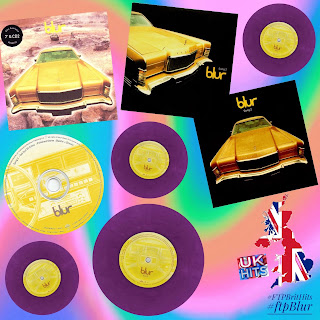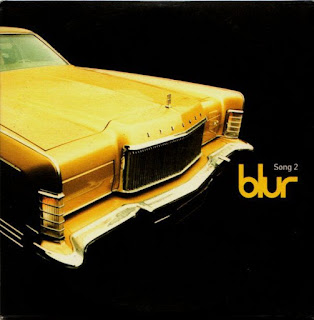Publicada: 7 d’abril de 1997
Regne Unit: núm. 2
“Song 2” és un tema del 1997 de la banda anglesa Blur, inclòs com a segon tall del seu cinquè àlbum d’estudi, “Blur”. Tot i tenir un títol provisional, la cançó es va convertir en un dels himnes més reconeguts dels anys 90, gràcies a la seva energia explosiva i el crit “Whoo-hoo!”. Va arribar al núm. 2 al Regne Unit, al núm. 4 a Austràlia i es va convertir en el major èxit internacional del grup, especialment als Estats Units, on va assolir el núm. 6 a la llista Modern Rock Tracks i s’hi va mantenir durant 26 setmanes. El single ha estat certificat triple platí al Regne Unit.
El títol “Song 2” era simplement un nom de treball: segona cançó del disc, segon senzill, i amb una durada de 2 minuts exactes. Tot i la seva simplicitat, el nom va quedar-se perquè tant la banda com els fans el van continuar utilitzant.
Musicalment, “Song 2” és una sàtira del grunge i l’alt-rock americà, gèneres que dominaven les llistes d’èxits als EUA a mitjans dels 90. Amb guitarres distorsionades, bateria potent i una actitud deliberadament “bruta”, la banda volia fer una paròdia del so americà, però irònicament, va ser el seu èxit més gran als Estats Units.
La cançó va néixer d’una sessió improvisada amb dues bateries i una actitud sense filtres. El baixista Alex James va descriure-la com “una idea brainless [sense cervell]” que funcionava precisament perquè no intentava ser perfecta. L’intent de refinar-la va fallar, i finalment, Blur va acceptar que l’autenticitat crua era la seva força.
Inicialment, Damon Albarn va cantar una lletra sense sentit com a guia vocal. El productor Stephen Street va insistir a mantenir aquella gravació original per la seva energia espontània. Albarn havia composat el tema a un ritme molt més lent, però el guitarrista Graham Coxon va accelerar-lo, creant-ne la versió vibrant que es coneix avui.
El videoclip, dirigit per Sophie Muller i nominat als MTV Video Music Awards, mostra el grup tocant en una habitació mentre l’energia del so els fa volar contra les parets, reflectint el caràcter explosiu de la cançó.
“Song 2” és un exemple emblemàtic de com l’instint artístic pot triomfar sobre la perfecció tècnica. Com va dir Alex James: “No cal polir-ho tot. A vegades, la primera cosa que fas és quan realment ho sents.”
BLUR - SONG 2
Released: April 7, 1997
UK: #2
“Song 2” is a 1997 track by English rock band Blur, featured as the second song on their self-titled fifth album. Released physically on 7 April 1997, the track became one of the band’s most iconic songs. It peaked at #2 on the UK Singles Chart, reached #4 in Australia, and became Blur’s most successful single in the United States, where it charted at #6 on Billboard’s Modern Rock Tracks, staying for 26 weeks, and hit #55 on the Hot 100 Airplay chart. The song is 2 minutes long, certified triple platinum in the UK, and is their most globally recognized hit.
Though widely known as “Whoo-Hooo” due to its explosive chorus, “Song 2” got its title simply as a working name—the second track on the album, second single, and two minutes long. Despite its placeholder title, the name stuck after fans and the band continued to use it informally during live performances.
Musically, “Song 2” is characterized by loud distorted guitars, gritty vocals, and an aggressive grunge-inspired sound. It was originally meant as a parody of American grunge and alternative rock, a genre dominating US charts at the time. Ironically, this tongue-in-cheek approach made it Blur’s biggest hit in America. The song was written spontaneously with minimal planning—Blur’s bassist Alex James recalled that it emerged from a chaotic jam session with two drum kits and an intentionally rough, “brainless” style. Attempts to polish or refine the track failed, and the band learned to embrace the raw, unfiltered nature of the recording.
Frontman Damon Albarn’s original vocal was just babbling, recorded as a guide. Producer Stephen Street insisted on keeping it, believing its spontaneous energy worked perfectly. Albarn initially composed the song at a much slower tempo, but guitarist Graham Coxon sped it up, which gave the track its frenetic energy. Albarn later admitted the faster version was vastly superior.
The song’s MTV Video Music Awards-nominated video, directed by Sophie Muller, features the band being hurled into walls by the sheer force of their amps during the explosive choruses.
“Song 2” is a case of artistic instinct triumphing over perfectionism. As Alex James summarized, it was “the realization you don’t have to polish everything. Sometimes the thing you do first is when you mean it.”




























